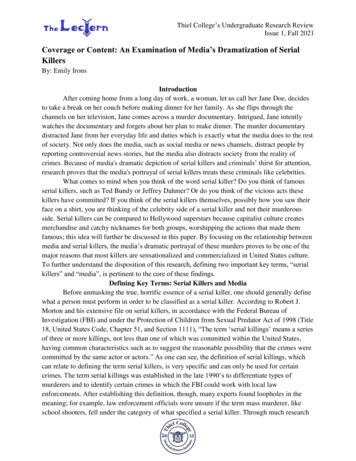
Transcription
Thiel College’s Undergraduate Research ReviewIssue 1, Fall 2021Coverage or Content: An Examination of Media’s Dramatization of SerialKillersBy: Emily IronsIntroductionAfter coming home from a long day of work, a woman, let us call her Jane Doe, decidesto take a break on her couch before making dinner for her family. As she flips through thechannels on her television, Jane comes across a murder documentary. Intrigued, Jane intentlywatches the documentary and forgets about her plan to make dinner. The murder documentarydistracted Jane from her everyday life and duties which is exactly what the media does to the restof society. Not only does the media, such as social media or news channels, distract people byreporting controversial news stories, but the media also distracts society from the reality ofcrimes. Because of media's dramatic depiction of serial killers and criminals’ thirst for attention,research proves that the media's portrayal of serial killers treats these criminals like celebrities.What comes to mind when you think of the word serial killer? Do you think of famousserial killers, such as Ted Bundy or Jeffrey Dahmer? Or do you think of the vicious acts thesekillers have committed? If you think of the serial killers themselves, possibly how you saw theirface on a shirt, you are thinking of the celebrity side of a serial killer and not their murderousside. Serial killers can be compared to Hollywood superstars because capitalist culture createsmerchandise and catchy nicknames for both groups, worshipping the actions that made themfamous; this idea will further be discussed in this paper. By focusing on the relationship betweenmedia and serial killers, the media’s dramatic portrayal of these murders proves to be one of themajor reasons that most killers are sensationalized and commercialized in United States culture.To further understand the disposition of this research, defining two important key terms, “serialkillers” and “media”, is pertinent to the core of these findings.Defining Key Terms: Serial Killers and MediaBefore unmasking the true, horrific essence of a serial killer, one should generally definewhat a person must perform in order to be classified as a serial killer. According to Robert J.Morton and his extensive file on serial killers, in accordance with the Federal Bureau ofInvestigation (FBI) and under the Protection of Children from Sexual Predator Act of 1998 (Title18, United States Code, Chapter 51, and Section 1111), “The term ‘serial killings’ means a seriesof three or more killings, not less than one of which was committed within the United States,having common characteristics such as to suggest the reasonable possibility that the crimes werecommitted by the same actor or actors.” As one can see, the definition of serial killings, whichcan relate to defining the term serial killers, is very specific and can only be used for certaincrimes. The term serial killings was established in the late 1990’s to differentiate types ofmurderers and to identify certain crimes in which the FBI could work with local lawenforcements. After establishing this definition, though, many experts found loopholes in themeaning; for example, law enforcement officials were unsure if the term mass murderer, likeschool shooters, fell under the category of what specified a serial killer. Through much research
The Lectern, Issue 1, Fall 2021of crimes and laws, scholars and law officials concluded on the following criteria to defining aserial killer: “One or more offenders; two or more murdered victims; incidents should beoccurring in separate events, at different times” (Morton). Morton also specifies that “the timeperiod between murders separates serial murder from mass murder.” In this case, schoolshooters, bar gunman, and other mass murderers are not considered serial killers. These setstandards not only help law enforcement classify criminals as serial killers, but the identificationof the term also helps society start to understand the true nature of the beast.Next, it is important to define the term “media” in relation to serial killers. The wordmedia implies all the different physical or technological forms of communication people use inorder to share information. “What Is Media? Definition and Meaning,” by Market BusinessNews, an online source, describes media as “the communication channels through which wedisseminate news, music, movies, education, promotional messages and other data.” Althoughthere are many types of outlets that fall under the media category, the word itself includes allthese forms in one general key word. For example, when I use the phrase “media’s portrayal ofseral killers,” this entails and is referring to news channels, newspapers, social media platforms,and other mediums that publicly display information to society. In short, media is definedbroadly, and serial killers is specific; these key terms will be useful for comprehending theresearch discovered on the relationship between media and serial killers.A Psychoanalysis of Serial Killers and Their BehaviorA final area needs to be covered before diving into the main points of this argument: thepsychology behind serial killers. While there is a large debate on whether evil derives fromnature or nurture, it is pertinent for researchers, scholars, and even society to examine the manyavenues of psychology pertaining to serial killers. In Hardwired Behavior by Laurence Tancredi,nature can be described as a person's genetics that make-up who they are, implying that thebiology of a person can be preconceived as bad thus making the individual born to be a badperson, or in the framework of this argument, a criminal. On the other hand, nurture is a person'senvironment and atmosphere; for example, an individual can have a “perfect life,” such ashaving great parents and living financially comfortably, and still become a serial killer (Tancredi61-2). The most common form of negative factors affecting the environment is childhoodtrauma. Trauma, such as child neglect or abuse, can greatly affect a person’s brain. It isimportant to note just how vital the brain is to the rest of body. Tancredi sufficiently explainshow much of a role the brain plays in decision making: “Because the brain is basic to decisionmaking, it must play a powerful role in our thinking regarding moral issues, and consequently inthe way we treat each other in our society to maintain order and uphold fairness, individualrights, and equity” (1). When the brain undergoes physical and mental mistreatment, like trauma,the brain still plays an important role, as mentioned by Tancredi; however, the role of the brainmay switch from the protagonist to the antagonist. Since the brain has a significant role indecision making, moral judgment, which is closely related to decision making, is anotherimportant topic to study when looking at serial killers.2
The Lectern, Issue 1, Fall 2021Tancredi’s work also explains the two types of judgement a person experiences whenpresented with a moral dilemma, which could lead to deciding to kill someone or not. The firsttype of judgment is personal judgment, or when a person's preconceived beliefs and senses comeinto play. When personal judgement is overwhelmed, actions without thought can be committed,such as a customer choking a salesperson over a dispute of a priced item. The second type ofjudgment is cognitive judgment that deals with impersonal and logic-based experiences. Forexample, if a person must choose between a train hitting five people or changing the tracks so thetrain only hits one person, the person choosing would most likely pick the second option becauseit does not affect them and it logically saves four people. Judgments become more subjective andharder to understand when more personal elements are involved (Tancredi). Now apply theinformation of the two types of judgment to serial killers. As calculated by the FBI’s Crime DataExplorer, 6,096 homicides were reported in 2019, and out of the 6,096 victims 1,024 victimswere complete strangers to the killer. As previously stated, moral dilemmas are easier to makewhen they are less personal, but when a traumatized brain is added into this equation, the easydecision is not always the right decision (Tancredi). When a killer with brain damage isexperiencing a moral dilemma of having the urge to kill someone, the act of murder is easier tocommit when the victim is a stranger because the killer has no personal ties. By analyzing thebrain’s crucial role to a person’s conscience and how damage can affect a person’s judgmentskills, society can get a better understanding of why killers commit these awful crimes,especially when these killers have experienced some sort of trauma. While the study of a serialkiller’s brain may seem like enough examination on a killer’s behavior, there is another modernfactor that plays into the influence of serial killers and their behavior – the media.Serial Killers in Popular CultureMurder documentaries on Netflix, serial killer coloring books, and Freddy KrugerHalloween costumes are all forms of media and merchandise that pay tribute to serial killers as ifthey are Hollywood stars. In the beginning, I focused on defining key terms and acknowledgingthe psychology behind murderers, specifically how trauma can affect their behavior. Now, Iextend this idea by answering why society gives so much attention to individuals once they havecommitted the gruesome act. In “Casting Cultural Monsters: Representations of Serial Killers inU.S. and U.K. News Media,” author Julie B. Wiest rationalizes, “Serial murder is deeplyembedded in Western cultures, and serial killers have become perverse icons as legendary asother monsters known throughout history in cultural myths” (327). News outlets have dramatizedserial killers so much that the public views serial killers as celebrities instead of what they reallyare: murderous offenders. To extend this idea further, reporting on serial killers can eveninfluence other people to kill so they can get the same attention serial killers receive from themedia. In Serial Killers, Joel Norris argues a circumstance where a serial killer successfullyinfluenced another killer; this second killer can be defined as a copycat killer: “The police fearedthat he would become a copycat killer who reacted to the news of the serial murderer bycommitting his own homicides” (13). A copycat killer is a prime example of how media reportson murderers can give the wrong idea to people who are looking for a way to grab society’s3
The Lectern, Issue 1, Fall 2021attention. On top of public awareness from reports and other forms of media, murderers arereceiving merchandise in their admiration justifying the crimes they have committed.Think of stores like Hot Topic or Spencer’s; these stores typically sell shirts andmerchandise displaying popular icons, such as serial murderers. Why do these stores, and manylike them, sell souvenirs flaunting killers and validating the crimes these criminals committed?Since mass media also entails physical items, shirts and mugs are considered forms of mediaresulting in other tactics for media platforms to further glorify the horrendous acts committed byperpetrators. Robert Conrath, author of “The Guys Who Shoot to Thrill: Serial Killers and theAmerican Popular Unconscious,” slaps society in the face by blatantly listing all the items serialkillers attain in their honor: “And finally, as with every hyped event or person, the serial killerhas found himself at the vortex of a complex network of merchandizing: biographies filmrights and made-for-TV movies, documentaries, but also the obligatory appendages of the cultureindustry—tee shirts, board games, comic books, trading cards, toy dolls, and Halloween masks”(150). Similarly to Conrath, Brian Jarvis, author of “Monsters Inc.: Serial killers and ConsumerCulture,” also notes the memorabilia murderers inherit with their names on it, calling it“murderabilia”:Murderabilia ranges from serial killer art (paintings, drawings, sculpture, letters, poetry),to body parts (a lock of hair or nail clippings), from crime scene materials to kitschmerchandising that includes serial killer T-Shirts, calendars, trading cards, board games,Halloween masks and even action figures of ‘superstars’ like Ted Bundy, Jeffrey Dahmerand John Wayne Gacy. (327)At one point, some serial killers, such as David Berkowitz nicknamed “Son of Sam,” attainedpayment from taking part in interviews for documentary content. While reading a list ofmemorabilia and opportunities of attention for serial killers seems useful, analyzing a real-lifecase of a serial killer, who basked in the grandeur of social media, is even more effective inunderstanding the actuality of this argument.“Son of Sam”: A Case StudyAccording to Meredith Worthen, author of “David Berkowitz” on Biography.com, DavidBerkowitz, also known as the “Son of Sam,” is a notorious serial killer known for his murders inthe Bronx and his catchy nickname. Born on June 1, 1953, in Brooklyn, New York, RichardDavid Falco was the son of a poor Jewish woman. Only a few days old, Falco was adopted byJewish hardware store owners, changing his last name from Falco to Berkowitz, in hopes ofgiving him a better life than if he would have stayed with his impoverished mother. Althoughthis plan was not ideal, Berkowitz became a troubled kid as he suffered greatly from the death ofhis biological mother. To escape reality, Berkowitz enlisted into the United States Army at theage of 18. After finishing his service in 1974, Berkowitz returned to New York City and obtaineda job as a U.S. Postal Service worker. From the outside, Berkowitz seemed like a quiet loner;however, New York City was not prepared for the terror Berkowitz would reign on the city(Worthen).4
The Lectern, Issue 1, Fall 2021Over the course of his killings, Berkowitz managed to murder six people and attack manymore from 1976 to 1977 creating his abominable legacy (Worthen). Berkowitz’s first victimswere Jody Valenti and Donna Lauria who were shot in a parked car on July 29, 1976. Berkowitzshot and injured another couple in a car a few months later. In November of that year, Berkowitzshot yet another set of two teenage girls. Lastly, an additional couple was shot and injured byBerkowitz within the same year of the previous shootings. Police did not know these shootingswere connected until they realized that the same weapon, a .44 caliber gun, was being used in allthe attacks. The use of the same weapon alarmed police, but for media this was the perfectopportunity to give the killer a catchy name as media named Berkowitz the “.44 caliber killer.”More innocent people were injured or killed from Berkowitz’s rampage, yet he was still roamingfreely. Eventually, Berkowitz left his first letter addressed to the New York Police Department(NYPD) captain explaining his crimes and calling himself the “Son of Sam” (Worthen). Asstated in The Encyclopedia of Serial Killers by Michael Newton, the letter penned, “But I am amonster, I am the Son of Sam” (16). These trails of letters would not only help police uncoverBerkowitz’s true identity, but these letters also made Berkowitz infamous for his terrible actions.While nicknaming serial killers and criminals seems light-hearted, these nicknamesactually “fueled the fire” by providing motivation to these perpetrators. Although Berkowitz’snickname, “Son of Sam,” seems entertaining, Berkowitz and other serial killers will work extrahard killing innocent people to live up to their name. Worthen states, “Throughout his murderousstreak, Berkowitz left numerous letters near his victims’ bodies, taunting the police and eludingtheir capture. As a result, the media coverage of his crimes was widespread and Berkowitzrelished the spotlight.” Worthen clearly notes how the media’s reports on his killings madeBerkowitz feel like a celebrity rather than what he truly was: a killer. Further, after being caughtby the police, Berkowitz told a story about a satanic possessed dog who told him to carry out thekillings, creating even more attention for Berkowitz: “[The] Labrador retriever was allegedlypossessed by ancient demons, beaming out commands for Berkowitz to kill and kill again”(Newton 17). After being incarcerated and attending therapy, Berkowitz took back his statementabout the possessed dog saying it was all fake and for attention: “Since his arrest, Berkowitz hasretracted his possessed dog ‘Son of Sam’ story — claiming ‘It was all a hoax, a silly hoax’ asseen in his March 20, 1979 letter to his psychiatrist, Dr. David Abrahamsen” (Worthen). The“Son of Sam” case is a prime example of how naming—or using a name given by the killersthemselves—and releasing the impractical stories told by murderers extends the publicity thesecriminals already obtain from the acts of violence they have committed. Lastly, what is importantto note about the “Son of Sam” case, specifically, is the compensation Berkowitz received whendoing television interviews and media broadcastings.When you think about Jane watching the murder documentary, does it cross your mind ifcriminals receive payment from partaking in television productions, similar to actors andactresses? While it is different state to state, recent laws have emerged in New York City, calledthe “Son of Sam laws,” which prohibits all criminals from collecting pay through interviews andmemorabilia: “Berkowitz has been paid substantial sums of money to share his story. However,5
The Lectern, Issue 1, Fall 2021nearly all states — including New York — have since passed laws, sometimes known as ‘Son ofSam laws,’ that prevent convicted criminals from financially profiting from books, movies, orother enterprises related to their crimes” (Worthen). While Berkowitz initially received payoutfor entertainment purposes, like interviews, recent laws have prevented present and futurecriminals to, essentially, be paid for their terrible deeds. Although this idea of funding serialkillers is now prohibited, these criminals are still put on societal pedestals with souvenirsmocking their murders, extensive murder mystery documentaries about their crimes, andinterviews that give these killers multiple chances to excuse why they carried out heinous acts.Afterall, it is the dramatic way that media outlets report on murderers that makes it possible forthese criminals to have their own coloring books.After hearing this argument about media giving too much attention to serial killers, manypeople might disagree with my theory and feel that reports on these perpetrators are mainly foremergency purposes. I acknowledge and even agree that news channels hold the power to alertthe nation about criminals in dire situations; however, it is the way media reports on these killersthat treats them like superstars. In “Murder as One of the Liberal Arts,” John Hitchcock declares,“ most true-crime reports are the equivalent of tabloid news” (277). How has society reachedthe point where crime reports are equivalent to “tabloid news” as stated by Hitchcock? Theanswer is that it is the media’s need for entertaining content rather than factual coverage that hasshaped society for the worse. Media has gone so far as to cast these criminals as celebrities thatserial killers have developed fan bases, like Taylor Swift’s fan base that is called “Swifties.” Asstated by Jack Levin in his book Serial Killers and Sadistic Murderers - Up Close and Personal,“Like other celebrities, serial killers have fans who flock to courtrooms during trials and prisonvisitation rooms after convictions, and they receive a substantial number of letters, visitors, andeven marriage proposals (Levin, 2008)” (qtd. in Wiest 331). It is one thing for fans to attentivelywatch murder documentaries, like Jane, but it is extreme for these fans to propose their romanticlove to these predators. I suspect that this infatuation with serial killers is a direct result from theromanticization of serial killers in the media. As previously discussed, media tends to nicknameserial killers or use the nickname serial killers provide for themselves, such as David Berkowitznaming himself “Son of Sam” in a letter he wrote to the NYPD. Besides creating a catchy phrasefor the title of a criminal report, there is no direct purpose for these nicknames when coveringserial killers. Putting all this together, media reports on criminals imitate “tabloid news”;extenuate the killer, which then makes fans fall in love with them; and establish fun labels forthese killers, ultimately making a serious subject amusing (Hitchcock 277). It is these dramaticmechanisms that turn crime reports into sick forms of entertainment where the killer is the star ofthe show. While the killer may seem like an important character, many people forget about thevictims and their role in the crime.The Impact of Media’s Dramatization of Serial Killers on VictimsNot only does dramatizing serial killer stories affect the perpetrator, but this approachalso affects the victims of the crime. As difficult as this may seem, imagine someone in yourfamily is brutally murdered by a serial killer. Still coping from this pain, you see shirts, mugs,6
The Lectern, Issue 1, Fall 2021memes, and various types of retail trending with the face of the killer who murdered your familymember. How does this make you feel? Are you angry that the killer is receiving more attentionthan your own, innocent family member? This scenario has happened countless times to thefamily and friends of innocent victims, and this scenario will continue to happen if media outletsdo not stop how they are reporting on criminals. Wiest emphasizes that “[i]n U.S. articles,victims are mostly invisible: They are included as numbers in body counts, rarely identified byname, with few details about their lives” (334). Media may categorize these victims as numbersin statistics; however, at the end of the day, these victims were children, parents, friends,partners, teammates, and, most importantly, innocent humans. Whether people agree or disagreewith the argument that media and news sites turn crime reports into entertaining anecdotes, allpeople should at least recognize the negative affects treating criminals like celebrities has had onvictims and their families. Understandably, it can be hard for members of society to exit thenever-ending circle of pop-culture; however, society should always be mindful of the people anditems they are supporting.Jane is still sitting on her couch watching the same murder documentary. About an hourhas passed, and Jane realizes that she forgot to make dinner for her family. She notes howmesmerized her mind was, watching the dramatic and entertaining murder show, that she forgotabout her own duties she has in real life. As members of society, we must not let the mediaoverrule our culture, popular icons, and daily life like Jane. Even if society gives in to marketingtactics and buys serial killer Halloween costumes, these consumers should be aware of what theyare buying and how their purchases can affect societal trends. People need to realize that themedia’s dramatic effect on crime stories ultimately treats evil serial killers like celebrities. Mediaoutlets have the power to influence pop-culture; however, it is up to society to distinguishwhether media reports on serial killers are for factual coverage or entertaining content.Emily Irons ‘24 is an Early Childhood and Special Education major from Franklin, PA.Works CitedConrath, Robert. “The Guys Who Shoot to Thrill: Serial Killers and the American PopularUnconscious.” Revue Française D'études Américaines, no. 60, 1994, pp. 143–152.JSTOR, www.jstor.org/stable/20872423. Accessed 24 Mar. 2021.“Expanded Homicide Offense Characteristics in the United States: Victim’s Relationship to theOffender, 2019.” Federal Bureau of Investigation Crime Data Explorer, Federal Bureauof Investigation, 2020, national/united-states/shr.Hitchcock, James. “Murder as One of the Liberal Arts.” American Scholar, vol. 63, no. 2, Spring1994, p. 277. EBSCOhost,search.ebscohost.com/login.aspx?direct true&db aph&AN 9403287783&site ehostlive.7
The Lectern, Issue 1, Fall 2021Jarvis, Brian. "Monsters Inc.: Serial killers and Consumer Culture." Crime, Media, Culture,2007, pp. 326-44. doi:10.1177/1741659007082469Newton, Michael. “Berkowitz, David Richard.” The Encyclopedia of Serial Killers. CheckmarkBooks, 200.Norris, Joel. Serial Killers. Anchor Book, Doubleday, 1989.Morton, Robert J. Serial Murder: Multi-Disciplinary Perspectives for Investigators. BehavioralAnalysis Unit-2, National Center for the Analysis of Violent Crime, Critical IncidentResponse Group, Federal Bureau of Investigation. ial-murder Accessed 5 Apr. 2021.Tancredi, Laurence. Hardwired Behavior. Cambridge UP, 2005. Accessed 29 Mar. 2021.“What Is Media? Definition and Meaning.” Market Business News, 13 Feb. sary/media-definition-meaning/ Accessed14 Apr. 2021.Wiest, Julie B. “Casting Cultural Monsters: Representations of Serial Killers in U.S. and U.K.News Media.” Howard Journal of Communications, vol. 27, no. 4, Oct. 2016, pp. 327–346. EBSCOhost, doi:10.1080/10646175.2016.1202876. Accessed 18 Mar. 2021.Worthen, Meredith. “David Berkowitz.” Biography.com, A&E Networks Television, 8Sept. 2020, www.biography.com/crime-figure/david-berkowitz. Accessed 5 Apr. 2021.8
psychology behind serial killers. While there is a large debate on whether evil derives from nature or nurture, it is pertinent for researchers, scholars, and even society to examine the many . person, or in the framework of this argument, a criminal. On the other hand, nurture is a person's environment and atmosphere; for example, an .











